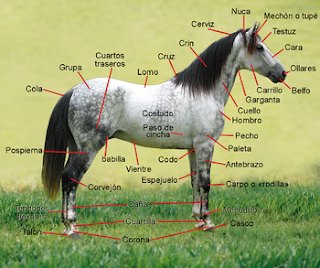Son animales gregarios y, por lo tanto, viven en manadas. No guardan muchas diferencias con sus antepasados salvajes.
Muchas de sus actitudes y comportamientos les permiten comunicarse con otros miembros de su grupo y expresar lo que desean. Los ojos, las orejas, los labios, la cola y su postura muestran indicios de lo que les pasa.
Por ejemplo, sus orejas son móviles y cambian de posición según su estado de ánimo. Las orejas adelantadas son un signo de curiosidad e interés, pero si se echan hacia atrás es porque el animal está asustado y nervioso.
Cuando un caballo está nervioso, también, suele golpear repetidamente los cascos contra el suelo, levantar su cola, abrir desmesuradamente sus ollares - los orificios de la nariz - y resoplar con mucha fuerza. Un caballo asustado puede ser muy agresivo.
Siempre están alerta. En estado salvaje los caballos podrían resultar presa fácil de los animales cazadores. Han desarrollado la capacidad de dormir de pie, y pueden pasar varias horas del día durmiendo en intervalos de unos 30 minutos aproximadamente. En estas circunstancias, para descansar cierran los ojos y bajan un poco la cabeza.
Cuando pelean por el liderazgo dentro de una manada o quieren exhibirse frente a las hembras, resultan muy peligrosos. Son capaces de encabritarse o empinarse, es decir, ponerse de pie sobre sus patas traseras y dar patadas en el aire para intimidar a su rival. En esta postura sus patas delanteras son las que dan equilibrio al cuerpo.
Los caballos se huelen para identificarse. Rozan su hocico contra el pelaje de los otros miembros de la manada y hasta se dan suaves mordiscos para reconocerse. Los potrillos suelen jugar, y es normal que se muerdan los crines como parte del juego.
Para limpiar su pelaje, estirar sus músculos y desentumecerse, los caballos ruedan con el lomo apoyado en el suelo.
Curiosidades: Fleischmann
Los caballos poseen un órgano en la parte superior del paladar que se conecta con la boca y la cavidad nasal. Para olfatear y detectar olores levantan la nariz, alzan el labio superior y llenan su boca de aire. Esta acción, que se llama fleischmann, les permite saber si una hembra está en condiciones de aparearse.
Many of their attitudes and behavior allow them to communicate with other members of their group and express what they want. The eyes, ears, lips, tail and posture show evidence of what happens.
For example, his ears are mobile and change position according to your mood. Advanced ears are a sign of curiosity and interest, but if you draw back is that the animal is scared and nervous.
When a horse is nervous, too, usually by knocking the helmets on the ground, lift your tail, widened her nostrils open - the nostrils - and puffing with great force. A frightened horse can be very aggressive.
They are always alert. In the wild horses could be easy prey for hunting animals. They have developed the ability to sleep standing, and may spend several hours a day sleeping at intervals of about 30 minutes. In these circumstances, to rest close their eyes and head slightly down.
When you fight for leadership within a herd or want to show off in front of females, are very dangerous. They are able to rear or steepen, ie stand on its hind legs kicking in the air to intimidate his opponent. In this position his front legs are what give balance to the body.
The horses smell to identify themselves. Rozan its snout against the fur of the other members of the pack and even give gentle bites to recognize. Foals usually play, and it is normal to bite the mane as part of the game.
To clean their fur, stretch your muscles and loosen up, the horses roll with the back resting on the ground.
Horses have an organ in the upper palate which connects with the mouth and nasal cavity. To sniff and detect smells up the nose, raise the upper lip and fill her mouth air. This action, called fleischmann, lets you know if a female is ready to mate.




No hay comentarios:
Publicar un comentario